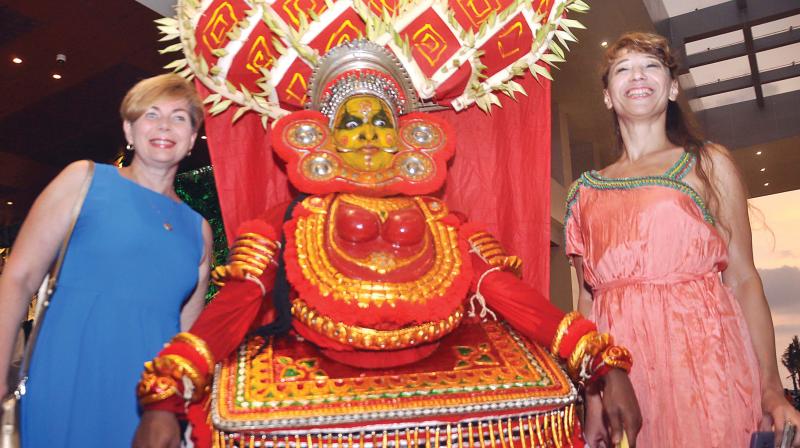Welcome back!

For Di Ball from Brisbane, Kerala, especially Fort Kochi, is a second home. Her first visit to Kerala was in 2012 during the Kochi-Muziris Biennale. Since then, it has been one of her favourite places and every year, she spends six months in Fort Kochi. She loves the place so much that she even cleaned the Fort Kochi Beach once, because it was heart breaking for Di, a beach lover, to see rubbish all over the place.
Now, Di is all excited as she will be coming to Kerala soon, especially after the state witnessed a devastating deluge. She is not afraid, but rather hopeful that Kerala will learn from its mistakes. “I actually hope that Kerala will rebuild sustainably and rubbish-free. It is a god-sent opportunity,” she believes. “My city Brisbane was hit by a huge flood in 2011 and we all joined together to build it back. I can see that same coming together in Kerala. Rebuild with an eco-friendly planning. For example, now the weeds and filthy canals are washed out. Don’t let them come back. Come together and let it not happen again. The time is now,” says Di.
Yes! The state echoes the same – It’s time. It’s time for the tourists to visit Kerala and for the state, to revive responsibly and sustainably. The tourism department has initiated a 12-point action plan to achieve that.
“After the floods, the Kerala Tourism suffered a setback. In the month of August alone, all tourism stake holders have estimated a loss of '500 crore. In the coming month, which marks the beginning of tourism season, they estimate a loss of around '1,500 crore. The 12-point action plan has been made to overcome this situation and revive Kerala Tourism,” says Rani George, secretary, Kerala Tourism.
As first step, the Tourism Department conducted a readiness survey in the state. “We identified 70 major destinations across the state and surveyed their status during a time frame of September 5 to 15. We checked transportation facilities and availability of hotels in those areas and found out that all major destinations have become operational. Only a few small destinations are yet to be operational. With this survey, the Kerala Tourism Department has started the campaign ‘It’s Time for Kerala’, which is going on in all platforms – print, audio, visual, outdoor and social media,” she adds.
The first chartered flight post the flood with 46 tourists from Australia landed in Cochin International Airport on September15, but that’s not all. More hard word needs to be done to bring in more tourists. The Kerala Travel Mart (KTM) organised in Kochi with support from the government aims to propagate the same. A large number of national and international buyers who visited the venue have realised that Kerala is safe to travel. “The Kerala Travel Mart Society has organised a tour for these delegates, so that they could go and experience themselves the safety of destinations. It will help reach us across the globe,” explains Rani.
Along with the Tourism Department, hoteliers and tour operators too are doing their bit to spread the word. They make use of both online and offline means to spread the word. “We are doing this for visibility. For instance, we have started a campaign in France saying Kerala is travel-friendly,” says Sujith Varghese, manager of a hotel group in Kochi. “The flood has created a panicky situation among tourists and made many believe that the state was washed away. However, after a month, things are positive, mainly because we could control epidemic outbreaks. The roads were affected, but now they have been restored. So, people are assured that Kerala is safe,” he adds.
However, the Deepavali season may not be lucrative, he says. “Not many bookings have been made for Deepavali. This fall may affect hotels in places like Kumarakom, Munnar and Thekkady. The hotel industry in Kochi will not get affected much as their revenue comes from European tourists who visit the place in December,” he says.
One thing everybody stresses during the revival mode is sustainable tourism as the need of the hour. “Our focus is responsible tourism, and this concept is based on sustainable tourism development,” says Rani. The village tourism package is one such step. “It will benefit the community,” Rani says. “Another plan is to identify 10 villages in the flood-affected areas and develop a package surrounding it. The RT Mission (Responsible Tourism Mission) is working on that. Chendamangalam, where the weavers’ community got affected, is an instance. The package not only will help the tourists to understand rural lifestyle, but also will help the community thrive,” she explains.
Sujith feels hoteliers too can take part in the mission by adopting eco-friendly measures. “One simple step is to avoid using plastic. We can effectively implement that if we try,” says Sujith.
As they all believe, an eco-friendly, sustainable tourism is possible with a combined effort of authorities and community members. “I used to see so much of self-thinking. Now, I see people thinking together. I hope this continues. Kerala can!” she says.
Yes, together we can!

